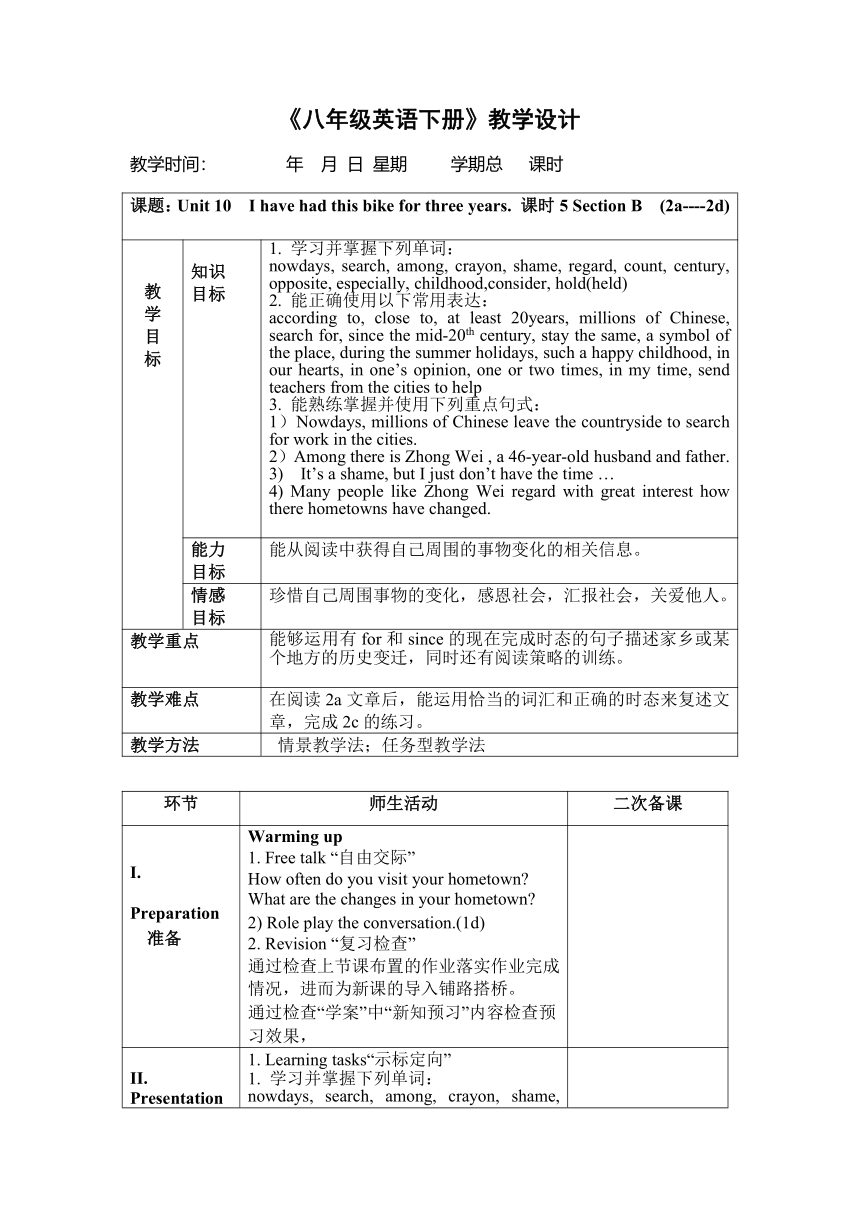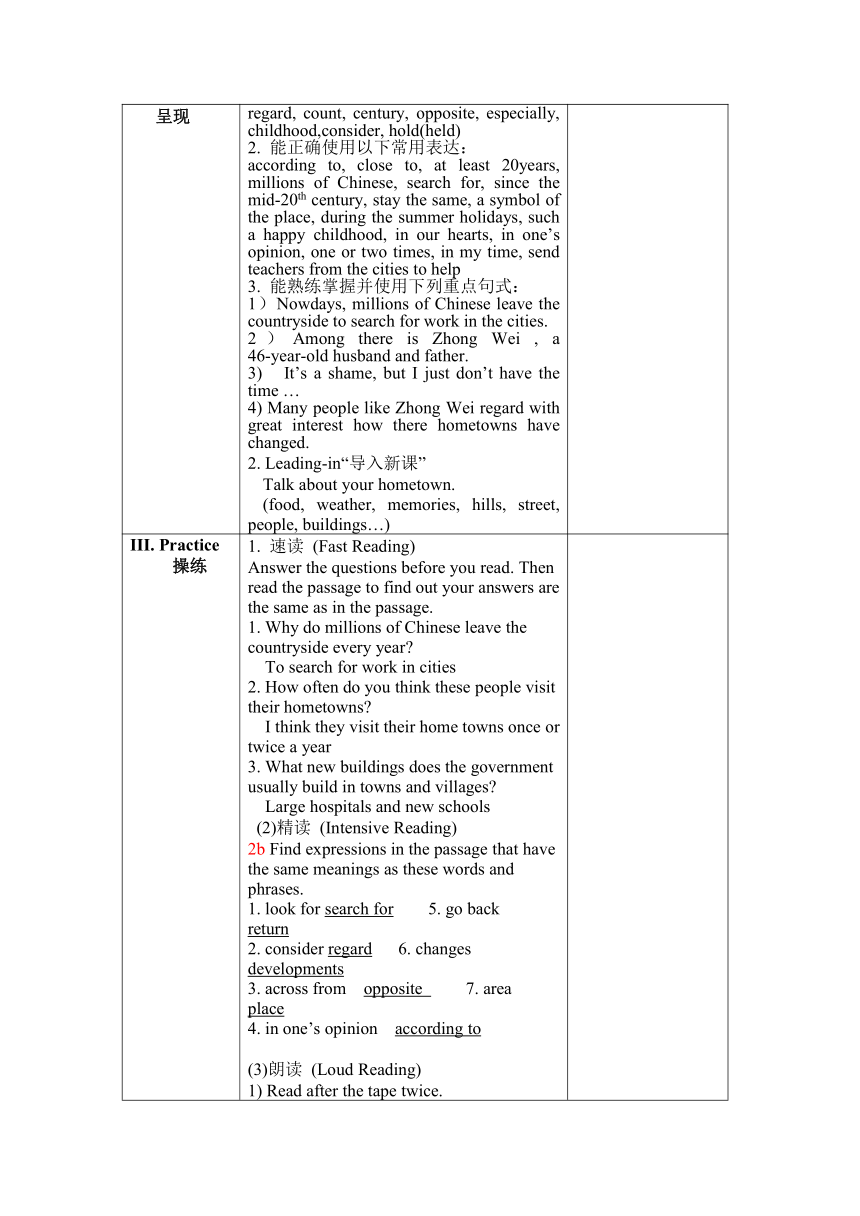人教八下英语 Unit 10 I have had this bike for three years. 课时5 Section B (2a-2d)教案
文档属性
| 名称 | 人教八下英语 Unit 10 I have had this bike for three years. 课时5 Section B (2a-2d)教案 |  | |
| 格式 | zip | ||
| 文件大小 | 20.0KB | ||
| 资源类型 | 教案 | ||
| 版本资源 | 人教新目标(Go for it)版 | ||
| 科目 | 英语 | ||
| 更新时间 | 2021-05-19 20:44:41 | ||
图片预览


文档简介
《八年级英语下册》教学设计
教学时间:
年
月
日
星期
学期总
课时
课题:Unit
10
I
have
had
this
bike
for
three
years.
课时5
Section
B
(2a----2d)
教
学
目
标
知识
目标
1.
学习并掌握下列单词:
nowdays,
search,
among,
crayon,
shame,
regard,
count,
century,
opposite,
especially,
childhood,consider,
hold(held)
2.
能正确使用以下常用表达:
according
to,
close
to,
at
least
20years,
millions
of
Chinese,
search
for,
since
the
mid-20th
century,
stay
the
same,
a
symbol
of
the
place,
during
the
summer
holidays,
such
a
happy
childhood,
in
our
hearts,
in
one’s
opinion,
one
or
two
times,
in
my
time,
send
teachers
from
the
cities
to
help
3.
能熟练掌握并使用下列重点句式:
1)Nowdays,
millions
of
Chinese
leave
the
countryside
to
search
for
work
in
the
cities.
2)Among
there
is
Zhong
Wei
,
a
46-year-old
husband
and
father.
3)
It’s
a
shame,
but
I
just
don’t
have
the
time
…
4)
Many
people
like
Zhong
Wei
regard
with
great
interest
how
there
hometowns
have
changed.
能力
目标
能从阅读中获得自己周围的事物变化的相关信息。
情感
目标
珍惜自己周围事物的变化,感恩社会,汇报社会,关爱他人。
教学重点
能够运用有for和since的现在完成时态的句子描述家乡或某个地方的历史变迁,同时还有阅读策略的训练。
教学难点
在阅读2a文章后,能运用恰当的词汇和正确的时态来复述文章,完成2c的练习。
教学方法
情景教学法;任务型教学法
环节
师生活动
二次备课
I.
Preparation
准备
Warming
up
1.
Free
talk
“自由交际”
How
often
do
you
visit
your
hometown?
What
are
the
changes
in
your
hometown?
2)
Role
play
the
conversation.(1d)
2.
Revision
“复习检查”
通过检查上节课布置的作业落实作业完成情况,进而为新课的导入铺路搭桥。
通过检查“学案”中“新知预习”内容检查预习效果,
II.
Presentation
呈现
1.
Learning
tasks“示标定向”
1.
学习并掌握下列单词:
nowdays,
search,
among,
crayon,
shame,
regard,
count,
century,
opposite,
especially,
childhood,consider,
hold(held)
2.
能正确使用以下常用表达:
according
to,
close
to,
at
least
20years,
millions
of
Chinese,
search
for,
since
the
mid-20th
century,
stay
the
same,
a
symbol
of
the
place,
during
the
summer
holidays,
such
a
happy
childhood,
in
our
hearts,
in
one’s
opinion,
one
or
two
times,
in
my
time,
send
teachers
from
the
cities
to
help
3.
能熟练掌握并使用下列重点句式:
1)Nowdays,
millions
of
Chinese
leave
the
countryside
to
search
for
work
in
the
cities.
2)Among
there
is
Zhong
Wei
,
a
46-year-old
husband
and
father.
3)
It’s
a
shame,
but
I
just
don’t
have
the
time
…
4)
Many
people
like
Zhong
Wei
regard
with
great
interest
how
there
hometowns
have
changed.
2.
Leading-in“导入新课”
Talk
about
your
hometown.
(food,
weather,
memories,
hills,
street,
people,
buildings…)
III.
Practice
操练
1.
速读
(Fast
Reading)
Answer
the
questions
before
you
read.
Then
read
the
passage
to
find
out
your
answers
are
the
same
as
in
the
passage.
1.
Why
do
millions
of
Chinese
leave
the
countryside
every
year?
To
search
for
work
in
cities
2.
How
often
do
you
think
these
people
visit
their
hometowns?
I
think
they
visit
their
home
towns
once
or
twice
a
year
3.
What
new
buildings
does
the
government
usually
build
in
towns
and
villages?
Large
hospitals
and
new
schools
(2)精读
(Intensive
Reading)
2b
Find
expressions
in
the
passage
that
have
the
same
meanings
as
these
words
and
phrases.
1.
look
for
search
for
5.
go
back
return
2.
consider
regard
6.
changes
developments
3.
across
from
opposite
7.
area
place
4.
in
one’s
opinion
according
to
(3)朗读
(Loud
Reading)
1)
Read
after
the
tape
twice.
2)
Read
the
passage
by
themselves,
and
then
give
some
of
them
show
time.
(4)
使用“学案”中【课堂探究】部分的内容,体验语法以及语言知识点的使用方法。
IV.
Consolidatin
巩固
Activity
2c:
2c
Complete
the
summary
with
words
from
the
passage.
You
may
need
to
change
the
forms
of
the
words.
Many
Chinese
people
these
days
leave
their
_________
to
work
in
_______.
They
usually
_____
to
their
hometown
one
or
two
times
a
______.
Zhong
Wei
hasn’t
been
back
in
close
to
three
years.
He
has
been
working
in
a
_____
factory
in
Wenzhou
for
the
past
13
years
People
like
him
are
_________
in
how
their
hometowns
are
changing.
New
buildings
are
often
built
by
the
___________.
Zhong
Wei
thinks
these
changes
are
______
because
things
need
to
change
in
order
to
become
better.
But
he
also
thinks
some
things
_________
change,
and
his
hometown
is
still
the
place
that
holds
all
his
childhood_________.
Keys:
hometown
cities
return
year
crayon
interested
government
good
will
never
memories
V.
Examination
检测
1.
引导学生小结梳理知识框架、规律、方法,并对合作小组当堂学习情况进行总结评价,巩固学生所获得的语言知识和经验,让学生在评价中反思,在反思中进步。
Ask
one
of
the
students
to
say
what
they
have
learnt.
1)words
2)
phrases
3)
sentences
2.
当堂检测(见学案):教师要随堂进行评价,批改可以由学习小组内互批、组间互批、集体订正等方法,批阅后教师要统计达标情况,收集反馈信息,当堂矫正补救。
VI.
Assignment
作业
1.
口头作业:
听并跟读录音,
尝试复述课文,背笔记。
2.
书面作业:
Remember
the
new
words
and
expressions
of
2a-2e.
Finish
off
the
exercises.
教学时间:
年
月
日
星期
学期总
课时
课题:Unit
10
I
have
had
this
bike
for
three
years.
课时5
Section
B
(2a----2d)
教
学
目
标
知识
目标
1.
学习并掌握下列单词:
nowdays,
search,
among,
crayon,
shame,
regard,
count,
century,
opposite,
especially,
childhood,consider,
hold(held)
2.
能正确使用以下常用表达:
according
to,
close
to,
at
least
20years,
millions
of
Chinese,
search
for,
since
the
mid-20th
century,
stay
the
same,
a
symbol
of
the
place,
during
the
summer
holidays,
such
a
happy
childhood,
in
our
hearts,
in
one’s
opinion,
one
or
two
times,
in
my
time,
send
teachers
from
the
cities
to
help
3.
能熟练掌握并使用下列重点句式:
1)Nowdays,
millions
of
Chinese
leave
the
countryside
to
search
for
work
in
the
cities.
2)Among
there
is
Zhong
Wei
,
a
46-year-old
husband
and
father.
3)
It’s
a
shame,
but
I
just
don’t
have
the
time
…
4)
Many
people
like
Zhong
Wei
regard
with
great
interest
how
there
hometowns
have
changed.
能力
目标
能从阅读中获得自己周围的事物变化的相关信息。
情感
目标
珍惜自己周围事物的变化,感恩社会,汇报社会,关爱他人。
教学重点
能够运用有for和since的现在完成时态的句子描述家乡或某个地方的历史变迁,同时还有阅读策略的训练。
教学难点
在阅读2a文章后,能运用恰当的词汇和正确的时态来复述文章,完成2c的练习。
教学方法
情景教学法;任务型教学法
环节
师生活动
二次备课
I.
Preparation
准备
Warming
up
1.
Free
talk
“自由交际”
How
often
do
you
visit
your
hometown?
What
are
the
changes
in
your
hometown?
2)
Role
play
the
conversation.(1d)
2.
Revision
“复习检查”
通过检查上节课布置的作业落实作业完成情况,进而为新课的导入铺路搭桥。
通过检查“学案”中“新知预习”内容检查预习效果,
II.
Presentation
呈现
1.
Learning
tasks“示标定向”
1.
学习并掌握下列单词:
nowdays,
search,
among,
crayon,
shame,
regard,
count,
century,
opposite,
especially,
childhood,consider,
hold(held)
2.
能正确使用以下常用表达:
according
to,
close
to,
at
least
20years,
millions
of
Chinese,
search
for,
since
the
mid-20th
century,
stay
the
same,
a
symbol
of
the
place,
during
the
summer
holidays,
such
a
happy
childhood,
in
our
hearts,
in
one’s
opinion,
one
or
two
times,
in
my
time,
send
teachers
from
the
cities
to
help
3.
能熟练掌握并使用下列重点句式:
1)Nowdays,
millions
of
Chinese
leave
the
countryside
to
search
for
work
in
the
cities.
2)Among
there
is
Zhong
Wei
,
a
46-year-old
husband
and
father.
3)
It’s
a
shame,
but
I
just
don’t
have
the
time
…
4)
Many
people
like
Zhong
Wei
regard
with
great
interest
how
there
hometowns
have
changed.
2.
Leading-in“导入新课”
Talk
about
your
hometown.
(food,
weather,
memories,
hills,
street,
people,
buildings…)
III.
Practice
操练
1.
速读
(Fast
Reading)
Answer
the
questions
before
you
read.
Then
read
the
passage
to
find
out
your
answers
are
the
same
as
in
the
passage.
1.
Why
do
millions
of
Chinese
leave
the
countryside
every
year?
To
search
for
work
in
cities
2.
How
often
do
you
think
these
people
visit
their
hometowns?
I
think
they
visit
their
home
towns
once
or
twice
a
year
3.
What
new
buildings
does
the
government
usually
build
in
towns
and
villages?
Large
hospitals
and
new
schools
(2)精读
(Intensive
Reading)
2b
Find
expressions
in
the
passage
that
have
the
same
meanings
as
these
words
and
phrases.
1.
look
for
search
for
5.
go
back
return
2.
consider
regard
6.
changes
developments
3.
across
from
opposite
7.
area
place
4.
in
one’s
opinion
according
to
(3)朗读
(Loud
Reading)
1)
Read
after
the
tape
twice.
2)
Read
the
passage
by
themselves,
and
then
give
some
of
them
show
time.
(4)
使用“学案”中【课堂探究】部分的内容,体验语法以及语言知识点的使用方法。
IV.
Consolidatin
巩固
Activity
2c:
2c
Complete
the
summary
with
words
from
the
passage.
You
may
need
to
change
the
forms
of
the
words.
Many
Chinese
people
these
days
leave
their
_________
to
work
in
_______.
They
usually
_____
to
their
hometown
one
or
two
times
a
______.
Zhong
Wei
hasn’t
been
back
in
close
to
three
years.
He
has
been
working
in
a
_____
factory
in
Wenzhou
for
the
past
13
years
People
like
him
are
_________
in
how
their
hometowns
are
changing.
New
buildings
are
often
built
by
the
___________.
Zhong
Wei
thinks
these
changes
are
______
because
things
need
to
change
in
order
to
become
better.
But
he
also
thinks
some
things
_________
change,
and
his
hometown
is
still
the
place
that
holds
all
his
childhood_________.
Keys:
hometown
cities
return
year
crayon
interested
government
good
will
never
memories
V.
Examination
检测
1.
引导学生小结梳理知识框架、规律、方法,并对合作小组当堂学习情况进行总结评价,巩固学生所获得的语言知识和经验,让学生在评价中反思,在反思中进步。
Ask
one
of
the
students
to
say
what
they
have
learnt.
1)words
2)
phrases
3)
sentences
2.
当堂检测(见学案):教师要随堂进行评价,批改可以由学习小组内互批、组间互批、集体订正等方法,批阅后教师要统计达标情况,收集反馈信息,当堂矫正补救。
VI.
Assignment
作业
1.
口头作业:
听并跟读录音,
尝试复述课文,背笔记。
2.
书面作业:
Remember
the
new
words
and
expressions
of
2a-2e.
Finish
off
the
exercises.
同课章节目录
- Unit 1 What's the matter?
- Section A
- Section B
- Unit 2 I'll help to clean up the city parks.
- Section A
- Section B
- Unit 3 Could you please clean your room?
- Section A
- Section B
- Unit 4 Why don't you talk to your parents?
- Section A
- Section B
- Unit 5 What were you doing when the rainstorm came
- Section A
- Section B
- Review of Units 1-5
- Unit 6 An old man tried to move the mountains.
- Section A
- Section B
- Unit 7 What's the highest mountain in the world?
- Section A
- Section B
- Unit 8 Have you read Treasure Island yet?
- Section A
- Section B
- Unit 9 Have you ever been to a museum?
- Section A
- Section B
- Unit 10 I've had this bike for three years.
- Section A
- Section B
